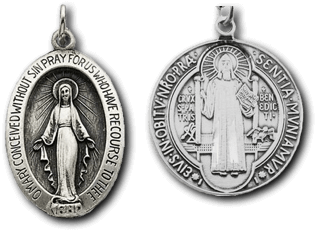Are Catholic 30 day consecrations suppose to be done by oneself or in a group?
QUESTION? / COMMENT!
According to Catholic tradition, norms and practices, are Catholic 30 day consecrations suppose to be done by oneself or in a group?
ANSWER! / COMMENT!
Catholic 30-day consecrations (or similar preparatory periods, such as those leading to Total Consecration to Jesus through Mary, inspired by St. Louis de Montfort, or adaptations like 30-day preparations to St. Joseph or the Sacred Heart) are devotional practices rooted in Catholic spirituality. They are not sacraments or formally mandated rites in the Church's liturgical law (e.g., as outlined in the Code of Canon Law or the Catechism of the Catholic Church, CCC §§ 1674–1676 on popular piety). Instead, they fall under private devotions or "pious exercises" encouraged by the Church for personal sanctification (Directory on Popular Piety and the Liturgy, Vatican 2001, §§ 197–200). Below, I'll explain the tradition, norms, and practices regarding whether they are to be done individually ("by oneself") or in a group, drawing from authoritative Catholic sources.
Key Principles from Catholic Tradition
Primary Purpose and Nature: These consecrations emphasize a personal, interior renewal and self-gift to God (often through Mary or a saint as a mediator). As St. Louis de Montfort writes in True Devotion to Mary (TDM, § 120–130), the preparation involves daily prayers, meditations, renunciation of sin, and spiritual readings to foster a "perfect consecration." This is inherently individualistic, mirroring the personal nature of conversion and prayer (CCC § 2558–2565 on prayer as a personal relationship with God). The act culminates in a formula of consecration (e.g., on a Marian feast day), which is a private vow or promise, not a public sacrament.
No Strict Requirement for Solo vs. Group:
Catholic norms do not prescribe one format exclusively. The Church allows flexibility in popular devotions to accommodate diverse needs (Directory on Popular Piety, § 58: "Pious exercises should be adapted to the faithful's capacity and circumstances"). They can be undertaken alone as a private retreat or in community for mutual support, but the essence remains personal—the consecration binds the individual's soul, not a collective.
Historical precedent: Early promoters like St. Louis de Montfort (1673–1716) and St. John Paul II (who made his own consecration privately as a young man) framed it as an individual journey, but communal adaptations emerged later (e.g., in 19th–20th century Marian apostolates like the Militia Immaculata founded by St. Maximilian Kolbe).
Individual (By Oneself) Practice: The Traditional Norm
This is the default and most common approach in Catholic tradition, aligning with the devotional texts:
St. Louis de Montfort's method (often adapted to 30 or 33 days) is designed for self-guided preparation: 12 preliminary days of emptying oneself of the "spirit of the world," followed by weeks focused on knowledge of self, Mary, and Christ (TDM §§ 227–233). Resources like his book or modern adaptations (e.g., 33 Days to Morning Glory by Fr. Michael Gaitley) provide daily readings, prayers (e.g., Litany of the Holy Spirit, Ave Maris Stella), and examinations of conscience to be done privately.
Why individual? It encourages introspection and avoids distractions. The Church's Congregation for Divine Worship notes that personal devotions foster "interior disposition" over external forms (Directory, § 197).
Examples in practice: Millions, including popes (e.g., Pius XII, John Paul II), have done this alone using books or apps. It's ideal for laypeople in daily life, with renewal recommended annually on one's own.
Group Practice: Allowed and Encouraged in Certain Contexts
Communal settings are a valid adaptation, not the origin, but supported for building fraternity (CCC § 2691 on communal prayer). This became more prominent post-Vatican II (1962–1965), emphasizing the Church as communion.
Parish or retreat-based groups: Many dioceses and orders (e.g., Marian Fathers of the Immaculate Conception) organize 30/33-day group programs, especially leading to feasts like the Immaculate Conception (Dec. 8) or Annunciation (Mar. 25). Participants meet weekly for shared meditations, but daily exercises remain personal. E.g., a group might discuss readings together, then pray individually.
Historical/traditional support: In monastic or sodality contexts (e.g., Legion of Mary groups), communal preparation strengthens resolve, echoing Acts 2:42 on early Christian community. St. Maximilian Kolbe promoted group enrollments in his "M.I." (Militia Immaculata) consecration movements.
Norms: Groups must avoid turning it into a "club" or obligatory rite—focus on voluntary participation and orthodoxy (avoiding syncretism or exaggeration, per Directory § 69). A priest may guide or witness the final consecration, but it's not required.
Recommendations and Best Practices
Start Individually if New: Tradition favors this for authenticity, as rushed group dynamics can dilute personal commitment (TDM § 134 warns against superficiality).
Incorporate Community Optionally: If seeking accountability, join a parish program (e.g., via formed.org or local Marian devotions). Renewals can be communal on feast days.
Official Church Guidance:
No Vatican mandate; it's extracurricular piety (CCC § 1679).
Consult a spiritual director for personalization (Canon 276 §2 on clergy/lay formation).
Valid for all baptized Catholics; indulgences may attach if conditions met (e.g., Enchiridion Indulgentiarum, norm 17 for Marian consecrations).
In summary, Catholic tradition norms lean toward individual practice as the core (self-guided preparation), with group options as a supportive enhancement where it aids devotion. Neither is "wrong"—choose based on your spiritual needs, as the goal is union with Christ (John Paul II, Redemptoris Mater, § 45). If this refers to a specific consecration (e.g., to Mary vs. St. Joseph), provide more details for tailored advice. For resources, see montfortmissionaries.org or vatican.va.




